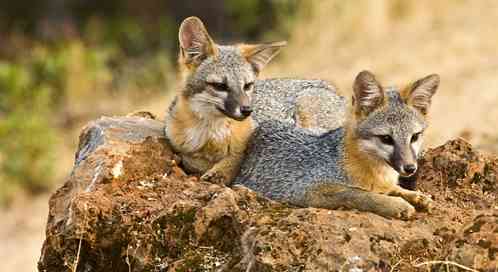Defenders and ranchers are working together to conserve land and species
by Heidi Ridgley

© Kevin Schafer / Minden Pictures
Dusk arrives just as a San Joaquin kit fox pops out of its den and scans the horizon—hoping for an easy meal. To survive, this fox species depends upon mice, kangaroo rats and other small animals that also call the California grasslands home. But with more and more prime habitat disappearing under shopping malls, roads and housing tracts, the future of this federally endangered fox is uncertain. Today, there are fewer than 7,000 of these housecat-sized foxes left. It is not alone in its plight.
California’s Central Valley, made up of 18 million acres of open grasslands, oak woodlands and wetlands, also provides crucial habitat for species that were once even more far ranging. They include raptors, such as the northern harrier and the peregrine falcon, along with the threatened California tiger salamander and California red-legged frog. In fact, there are 75 plant and animal species associated with California grasslands that are protected as threatened or endangered under the Endangered Species Act. “This land has an amazing wealth of biological diversity but much of it is imperiled,” says Defenders’ Pelayo Alvarez. “That’s why it is vitally important we work with landowners to maintain or restore the land and then protect it.”
The majority of the Central Valley is privately owned and managed as rangelands for livestock production, which in the age of sprawling suburbs, now provides some of the last and best remaining habitat for these species. Research has shown that several amphibian and butterfly species actually depend on grazing livestock because the animals prefer to eat exotic grasses, which are high in nitrogen, leaving more space for wildflowers and other native vegetation on which wildlife depend. Even kit foxes benefit from large grazers, as they favor flat and open space to avoid predators.
Recognizing the biological importance of these rangelands and, in an attempt to keep the concrete jungle at bay, Defenders of Wildlife’s California office formed an alliance with the California Cattlemen’s Association in 2005 to create the California Rangeland Conservation Coalition. Alvarez directs the coalition’s conservation programs. Today, the group has more than 100 members working to save 11 million acres in the Central Valley through conservation easements and restoration projects. More than 1 million of those acres fall within essential kit fox habitat.
“California loses 20,000 acres of rangelands to urbanization and other uses every year,” says Alvarez. “Conserving biodiversity in the Central Valley is inextricably linked to private ranching. These ranchers have been investing in conservation for generations by fencing riparian areas, building and maintaining stock ponds, and grazing sustainably.”
Defenders is also working with the coalition to develop markets and incentives to keep rangelands open space. Through a grant from the U.S. Department of Agriculture, Defenders surveyed ranchers to get their opinion on how to create incentive-based programs that reward ranchers for good stewardship practices. Defenders also works with coalition partners to help water utilities, for example, identify lands that are especially important for preserving watersheds and then to protect them through conservation easements.
“In addition to providing habitat for imperiled wildlife, rangelands help in the fight against climate change by capturing carbon, and they filter and clean our water and stave off erosion,” says Alvarez. “Protecting privately owned rangelands in California’s Central Valley is a very cost-effective way of conserving biodiversity and all the other ecosystem services that we all benefit from. These ranching families care deeply about the land they own and have been stewarding for hundreds of years. Keeping them on the land is important to local economies and the cultural legacy of our rural communities.”
Only select articles from Defenders are available online. To receive 4 issues annually of the full award-winning magazine, become a member of Defenders of Wildlife!

